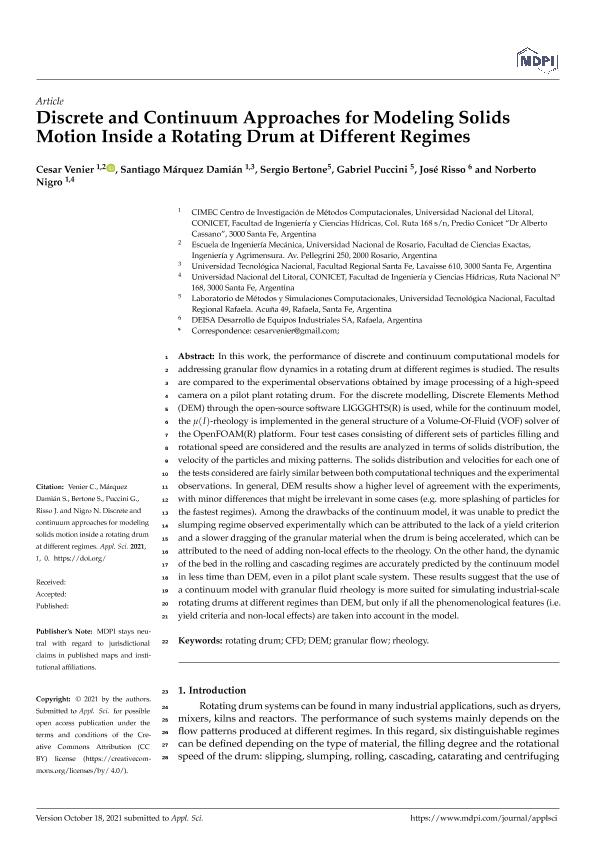Mostrar el registro sencillo del ítem
dc.contributor.author
Venier, César Martín

dc.contributor.author
Marquez Damian, Santiago

dc.contributor.author
Bertone, Sergio Eduardo

dc.contributor.author
Puccini, Gabriel Darío

dc.contributor.author
Risso, José María
dc.contributor.author
Nigro, Norberto Marcelo

dc.date.available
2023-01-13T12:51:49Z
dc.date.issued
2021-11
dc.identifier.citation
Venier, César Martín; Marquez Damian, Santiago; Bertone, Sergio Eduardo; Puccini, Gabriel Darío; Risso, José María; et al.; Discrete and continuum approaches for modeling solids motion inside a rotating drum at different regimes; MDPI; Applied Sciences (Switzerland); 11; 21; 11-2021; 1-23
dc.identifier.issn
2076-3417
dc.identifier.uri
http://hdl.handle.net/11336/184643
dc.description.abstract
In this work, the performance of discrete and continuum computational models for ad-dressing granular flow dynamics in a rotating drum at different regimes is studied. The results are compared to the experimental observations obtained by image processing of a high-speed camera on a pilot plant rotating drum. For the discrete modeling, Discrete Elements Method (DEM) through the open-source software LIGGGHTS(R) is used, while for the continuum model, the µ(I)-rheology is implemented in the general structure of a Volume-Of-Fluid (VOF) solver of the OpenFOAM(R) platform. Four test cases consisting of different sets of particles filling and rotational speed are considered and the results are analyzed in terms of solids distribution, the velocity of the particles, and mixing patterns. The solids distribution and velocities for each one of the tests considered are fairly similar between both computational techniques and the experimental observations. In general, DEM results show a higher level of agreement with the experiments, with minor differences that might be irrelevant in some cases (e.g., more splashing of particles for the fastest regimes). Among the drawbacks of the continuum model, it was unable to predict the slumping regime observed experimentally which can be attributed to the lack of a yield criterion and a slower dragging of the granular material when the drum is being accelerated, which can be attributed to the need of adding non-local effects to the rheology. On the other hand, the dynamic of the bed in the rolling and cascading regimes are accurately predicted by the continuum model in less time than DEM, even in a pilot plant scale system. These results suggest that the use of a continuum model with granular fluid rheology is more suited for simulating industrial-scale rotating drums at different regimes than DEM, but only if all the phenomenological features (i.e., yield criteria and non-local effects) are taken into account in the model.
dc.format
application/pdf
dc.language.iso
eng
dc.publisher
MDPI
dc.rights
info:eu-repo/semantics/openAccess
dc.rights.uri
https://creativecommons.org/licenses/by/2.5/ar/
dc.subject
CFD
dc.subject
DEM
dc.subject
GRANULAR FLOW
dc.subject
RHEOLOGY
dc.subject
ROTATING DRUM
dc.subject.classification
Mecánica Aplicada

dc.subject.classification
Ingeniería Mecánica

dc.subject.classification
INGENIERÍAS Y TECNOLOGÍAS

dc.title
Discrete and continuum approaches for modeling solids motion inside a rotating drum at different regimes
dc.type
info:eu-repo/semantics/article
dc.type
info:ar-repo/semantics/artículo
dc.type
info:eu-repo/semantics/publishedVersion
dc.date.updated
2022-09-21T11:13:41Z
dc.journal.volume
11
dc.journal.number
21
dc.journal.pagination
1-23
dc.journal.pais
Suiza

dc.journal.ciudad
Basilea
dc.description.fil
Fil: Venier, César Martín. Consejo Nacional de Investigaciones Científicas y Técnicas. Centro Científico Tecnológico Conicet - Santa Fe. Centro de Investigaciones en Métodos Computacionales. Universidad Nacional del Litoral. Centro de Investigaciones en Métodos Computacionales; Argentina
dc.description.fil
Fil: Marquez Damian, Santiago. Consejo Nacional de Investigaciones Científicas y Técnicas. Centro Científico Tecnológico Conicet - Santa Fe. Centro de Investigaciones en Métodos Computacionales. Universidad Nacional del Litoral. Centro de Investigaciones en Métodos Computacionales; Argentina
dc.description.fil
Fil: Bertone, Sergio Eduardo. Universidad Tecnológica Nacional; Argentina
dc.description.fil
Fil: Puccini, Gabriel Darío. Universidad Tecnológica Nacional; Argentina
dc.description.fil
Fil: Risso, José María. No especifíca;
dc.description.fil
Fil: Nigro, Norberto Marcelo. Consejo Nacional de Investigaciones Científicas y Técnicas. Centro Científico Tecnológico Conicet - Santa Fe. Centro de Investigaciones en Métodos Computacionales. Universidad Nacional del Litoral. Centro de Investigaciones en Métodos Computacionales; Argentina
dc.journal.title
Applied Sciences (Switzerland)
dc.relation.alternativeid
info:eu-repo/semantics/altIdentifier/doi/http://dx.doi.org/10.3390/app112110090
Archivos asociados
